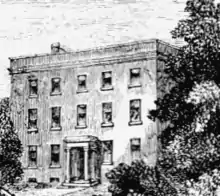Joseph Hurlock
Joseph Hurlock (c.1715 – 1793) was a director of the East India Company.
Joseph Hurlock | |
|---|---|
| Born | 1715 |
| Died | 1793 |
| Nationality | British |
| Occupation | Director of the East India Company |
Life
Hurlock became a writer for British Bencoolen on 23 October 1730.[1] One of his sureties with the East India Company was Joseph Hurlock the London surgeon, and Shirren takes him to be a relation; he mentions also some Hurlocks buried in a Chelsea Moravian Church cemetery as possibly related.[2]
It was 12 July 1731 when Hurlock arrived on the coast of Sumatra.[3] In 1745 he was resident at Moco Moco facing the threat of escaped slaves.[4] He was later deputy-governor at Fort Marlborough, the main Bencoolen fortification, from 1746 to 1752.[5] His successor was Robert Hindley, who paid substantially for Hurlock's resignation.[6]

Hurlock returned to England in 1752, on board the Onslow, captain Thomas Hinde.[7] He married, and resided at Fleetwood House, the home of the Hartopp family.[8] After his wife's death in 1766, the house was let out.[9] He subsequently lived in John Street, London.[10] At the end of his life he was at Lindsey House, 99 Cheyne Walk, Chelsea.[11]
Hurlock was an East India Company director in 1768, and again later.[12] He was a Fellow of the Royal Society and involved with the Society of Arts as a committee chairman.[13] He was buried at Stoke Newington on 15 August 1793, having died aged 78.[14] A monument was created to him, in Stoke Newington Church, by Thomas Banks for his daughter Ann. It records his date of death as 10 August.[15][16]
Family
Hurlock married in June 1755 Sarah Hartopp, daughter of Sir John Hartopp, 4th Baronet, who died in 1766. Their daughter Anne married Edmund Bunney, later known as Edmund Cradock-Hartopp.[17]
Notes
- Adam John Shirren (1951). The Chronicles of Fleetwood House. Pacesetter Press. p. 134.
- Adam John Shirren (1951). The Chronicles of Fleetwood House. Pacesetter Press. pp. 136, 138.
- Adam John Shirren (1951). The Chronicles of Fleetwood House. Pacesetter Press. p. 136.
- Richard B. Allen (1 January 2015). European Slave Trading in the Indian Ocean, 1500–1850. Ohio University Press. p. 32. ISBN 978-0-8214-4495-5.
- John Stewart (1996). The British Empire: An Encyclopedia of the Crown's Holdings, 1493 Through 1995. McFarland & Company. p. 92. ISBN 978-0-7864-0177-2.
- Ian Bruce Watson (1 January 1980). Foundation for Empire: English Private Trade in India, 1659-1760. Vikas. pp. 174–5 note 24. ISBN 978-0-7069-1038-4.
- Adam John Shirren (1951). The Chronicles of Fleetwood House. Pacesetter Press. pp. 136–7.
- Notes and Queries. Oxford University Press. 1872. p. 364.
- A P Baggs, Diane K Bolton and Patricia E C Croot, Stoke Newington: Other estates, in A History of the County of Middlesex: Volume 8, Islington and Stoke Newington Parishes, ed. T F T Baker and C R Elrington (London, 1985), pp. 178-184. British History Online http://www.british-history.ac.uk/vch/middx/vol8/pp178-184 [accessed 3 January 2017].
- Transactions of the Society, Instituted at London, for the Encouragement of Arts, Manufactures, and Commerce. The Society. 1806. p. 295.
- Adam John Shirren (1951). The Chronicles of Fleetwood House. Pacesetter Press. p. 138.
- Bengal: Past and Present. Calcutta Historical Society. 1931. p. 158.
- Transactions of the Society of Arts. 1788. p. 236.
- Cokayne, George Edward (1900). "Complete Baronetage". Internet Archive. Exeter: W. Pollard & Co. pp. 132 note b. Retrieved 3 January 2017.
- Gunnis, Rupert (1968). Dictionary of British Sculptors 1660–1851 (Revised ed.). p. 40.
- Adam John Shirren (1951). The Chronicles of Fleetwood House. Pacesetter Press. p. 138.
- William Robinson (1820). The History and Antiquities of the Parish of Stoke Newington. John Nichols and Son. p. 79.